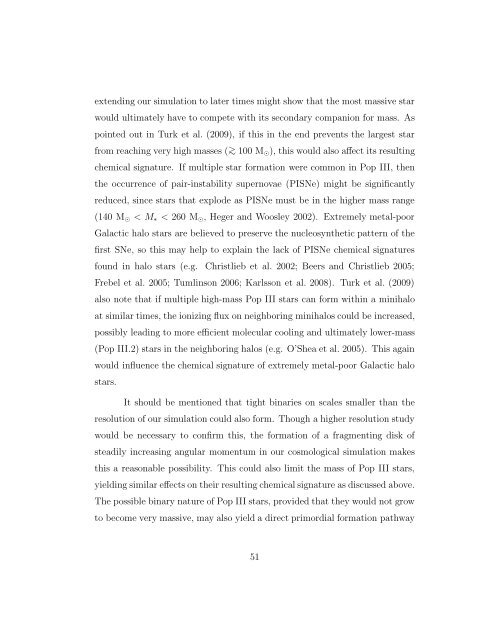Copyright by Athena Ranice Stacy 2011 - The University of Texas at ...
Copyright by Athena Ranice Stacy 2011 - The University of Texas at ...
Copyright by Athena Ranice Stacy 2011 - The University of Texas at ...
Create successful ePaper yourself
Turn your PDF publications into a flip-book with our unique Google optimized e-Paper software.
extending our simul<strong>at</strong>ion to l<strong>at</strong>er times might show th<strong>at</strong> the most massive star<br />
would ultim<strong>at</strong>ely have to compete with its secondary companion for mass. As<br />
pointed out in Turk et al. (2009), if this in the end prevents the largest star<br />
from reaching very high masses (> ∼ 100 M⊙), this would also affect its resulting<br />
chemical sign<strong>at</strong>ure. If multiple star form<strong>at</strong>ion were common in Pop III, then<br />
the occurrence <strong>of</strong> pair-instability supernovae (PISNe) might be significantly<br />
reduced, since stars th<strong>at</strong> explode as PISNe must be in the higher mass range<br />
(140 M⊙ < M∗ < 260 M⊙, Heger and Woosley 2002). Extremely metal-poor<br />
Galactic halo stars are believed to preserve the nucleosynthetic p<strong>at</strong>tern <strong>of</strong> the<br />
first SNe, so this may help to explain the lack <strong>of</strong> PISNe chemical sign<strong>at</strong>ures<br />
found in halo stars (e.g. Christlieb et al. 2002; Beers and Christlieb 2005;<br />
Frebel et al. 2005; Tumlinson 2006; Karlsson et al. 2008). Turk et al. (2009)<br />
also note th<strong>at</strong> if multiple high-mass Pop III stars can form within a minihalo<br />
<strong>at</strong> similar times, the ionizing flux on neighboring minihalos could be increased,<br />
possibly leading to more efficient molecular cooling and ultim<strong>at</strong>ely lower-mass<br />
(Pop III.2) stars in the neighboring halos (e.g. O’Shea et al. 2005). This again<br />
would influence the chemical sign<strong>at</strong>ure <strong>of</strong> extremely metal-poor Galactic halo<br />
stars.<br />
It should be mentioned th<strong>at</strong> tight binaries on scales smaller than the<br />
resolution <strong>of</strong> our simul<strong>at</strong>ion could also form. Though a higher resolution study<br />
would be necessary to confirm this, the form<strong>at</strong>ion <strong>of</strong> a fragmenting disk <strong>of</strong><br />
steadily increasing angular momentum in our cosmological simul<strong>at</strong>ion makes<br />
this a reasonable possibility. This could also limit the mass <strong>of</strong> Pop III stars,<br />
yielding similar effects on their resulting chemical sign<strong>at</strong>ure as discussed above.<br />
<strong>The</strong> possible binary n<strong>at</strong>ure <strong>of</strong> Pop III stars, provided th<strong>at</strong> they would not grow<br />
to become very massive, may also yield a direct primordial form<strong>at</strong>ion p<strong>at</strong>hway<br />
51









